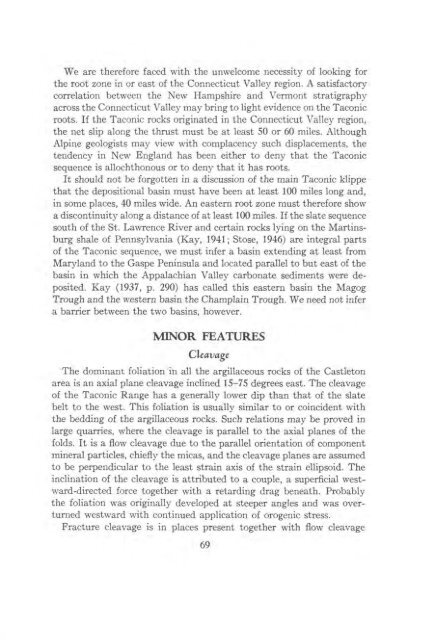STRATIGRAPHY AND STRUCTURE CASTLETON AREA VERMONT
STRATIGRAPHY AND STRUCTURE CASTLETON AREA VERMONT
STRATIGRAPHY AND STRUCTURE CASTLETON AREA VERMONT
Create successful ePaper yourself
Turn your PDF publications into a flip-book with our unique Google optimized e-Paper software.
We are therefore faced with the unwelcome necessity of looking for<br />
the root zone in or east of the Connecticut Valley region. A satisfactory<br />
correlation between the New Hampshire and Vermont stratigraphy<br />
across the Connecticut Valley may bring to light evidence on the Taconic<br />
roots. If the Taconic rocks originated in the Connecticut Valley region,<br />
the net slip along the thrust must be at least 50 or 60 miles. Although<br />
Alpine geologists may view with complacency such displacements, the<br />
tendency in New England has been either to deny that the Taconic<br />
sequence is allochthonous or to deny that it has roots.<br />
It should not be forgotten in a discussion of the main Taconic klippe<br />
that the depositional basin must have been at least 100 miles long and,<br />
in some places, 40 miles wide. An eastern root zone must therefore show<br />
a discontinuity along a distance of at least 100 miles. If the slate sequence<br />
south of the St. Lawrence River and certain rocks lying on the Martinsburg<br />
shale of Pennsylvania (Kay, 1941; Stose, 1946) are integral parts<br />
of the Taconic sequence, we must infer a basin extending at least from<br />
Maryland to the Gaspe Peninsula and located parallel to but east of the<br />
basin in which the Appalachian Valley carbonate sediments were deposited.<br />
Kay (1937, p. 290) has called this eastern basin the Magog<br />
Trough and the western basin the Champlain Trough. We need not infer<br />
a barrier between the two basins, however.<br />
MINOR FEATURES<br />
Cleavage<br />
The dominant foliation in all the argillaceous rocks of the Castleton<br />
area is an axial plane cleavage inclined 15-75 degrees east. The cleavage<br />
of the Taconic Range has a generally lower dip than that of the slate<br />
belt to the west. This foliation is usually similar to or coincident with<br />
the bedding of the argillaceous rocks. Such relations may be proved in<br />
large quarries, where the cleavage is parallel to the axial planes of the<br />
folds. It is a flow cleavage due to the parallel orientation of component<br />
mineral particles, chiefly the micas, and the cleavage planes are assumed<br />
to be perpendicular to the least strain axis of the strain ellipsoid. The<br />
inclination of the cleavage is attributed to a couple, a superficial westward-directed<br />
force together with a retarding drag beneath. Probably<br />
the foliation was originally developed at steeper angles and was overturned<br />
westward with continued application of orogenic stress.<br />
Fracture cleavage is in places present together with flow cleavage<br />
69













